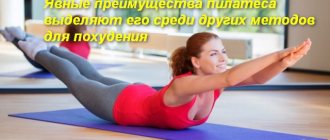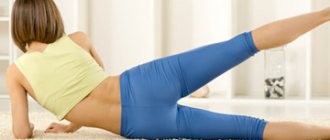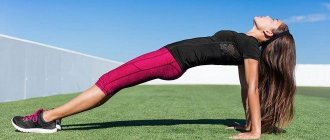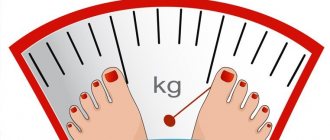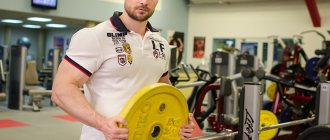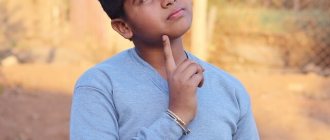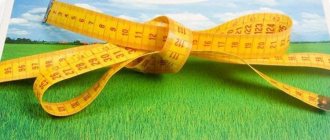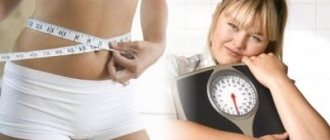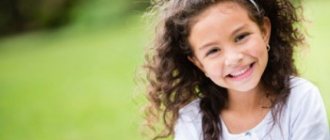Where did the Pilates system come from?
This system has become popular in our country relatively recently. And, like many other things, it gained its fame thanks to its popularity among pop stars and other public celebrities. The lightning-fast spread of the system among people who care about their health is explained by its effectiveness and focus on the exercises performed. Meanwhile, the system is already more than a hundred years old.
This set of exercises received its name in honor of the man who invented and developed it - Joseph Hubert Pilates .
In 1880, in a small German town located near Düsseldorf, a very weak and sickly boy was born. It is hard to imagine that determination, perseverance and careful attention to his own body helped little Joseph overcome diseases such as rheumatic fever and other diseases. Already at the age of fourteen, thanks to his own system of exercises, young Pilates had excellent health, the body of an athlete and the appearance of a model.
When Joseph immigrated to the United States in 1926, his famous system gained new fans and adherents. It was from there, from America, that this method of training the body began its victorious march throughout the world. Despite some transformation and adaptation to modern reality, the Pilates system, today, still relies on the dogmas that were proposed by its author.
Simple and effective exercises for excellent physical shape
There are more than a hundred exercises and individual techniques created for weight loss - from light gymnastics for the main muscle groups to powerful strength training.
The place of the “golden mean” in this training range is rightfully occupied by Pilates, which carefully develops muscles, makes the body elastic and strengthens the body on all fronts - literally. After all, Pilates was originally intended for the rehabilitation of injured athletes and dancers, and a set of exercises was developed by the American trainer Joseph Pilates almost 100 years ago. The technique turned out to be so effective that as a result it turned into a popular trend - Pilates for weight loss, and is suitable even for physically unprepared people.
What is the Pilates system?
Today, many people want to find out in more detail for themselves what Pilates is, what benefits the system brings and who can practice this program. Like any set of physical exercises, the Pilates system is based on a certain load that a person experiences during physical education and sports. However, this complex contains several significant differences from other systems, due to which Pilates has come to be considered unique.
First of all, since Pilates exercises are performed slowly , measuredly and smoothly , it is almost impossible to get injured during training. The main goal of the system is to teach you to feel your body, feel every muscle and every bone. As you master the technique, you will be able to learn to manage not only your own well-being, but also independently “sculpt” yourself the body you have always dreamed of.
The basis of the system is exercises for the whole body, developing flexibility, mobility and strengthening the transverse and rectus abdominis muscles , which Joseph Pilates called the “framework of strength.” Combining proper breathing with smooth, focused movements allows you to gently and consistently strengthen muscles without building muscle mass . At the same time, those muscles that you didn’t even know about are included in the work during training.
A gentle and, at the same time, consistent, deep impact on the body results in amazing achievements if you follow the principles of the Pilates system :
- correct breathing
- conscious concentration
- constant monitoring of the “strength frame”
- smoothness and softness of movements
- concentration
- regularity of exercises
By doing Pilates under the guidance of a competent trainer or just at home, you can strengthen your body, lose excess weight and get rid of many diseases.
Why and who needs this exercise system?
The Pilates exercise system can confidently be called one of the most effective and safe systems. People of any gender and age can perform the complex , regardless of their physical fitness.
In addition to general improvement of the body, Pilates allows you to solve such health problems as: headaches, spinal injuries, osteoparosis, osteoarthritis, back pain, stress, etc. In addition, doctors around the world actively use this system during the recovery period of patients who have suffered severe injuries.
Pilates is very popular for weight loss.
Using a special complex, you can purposefully correct your figure , getting rid of extra pounds in the right places. Moreover, women who are preparing to become mothers can absolutely fearlessly practice this method both during pregnancy, strengthening the muscles of the abdomen, pelvis and lower back, and in the postpartum period, in order to quickly regain their previous slimness and beauty.
Practicing the Pilates exercise system, many people, after some time, note a surge of strength, general rejuvenation of the body and the absence of negative emotions. It should be noted that the system helps improve brain function and helps develop intuition, logical thinking, memory, etc. In our fast-paced times, such abilities are just a gift that can be received by anyone who strives to improve not only the body, but also souls.
What are the advantages over other systems?
Many sets of exercises are based on physical activity of the body. The Pilates system is also no exception and you will have to make some effort to practice. However, there is a main difference that transfers this system from the category of mechanical influence on the body to the category of targeted training of the body.
The fact is that Pilates demonstrates an integrated approach to the entire body at the same time, and not to a single muscle group. You don't train your back, abs or legs separately, you train them all in one complex.
The loads are distributed in such a way that the maximum amount of muscle mass is worked out at the same time. In addition, in addition to simply automatically performing exercises, such as exercises on machines, all movements in Pilates harmoniously complement each other and require focus and concentration.
A person who practices this system feels his body very well and consciously directs the necessary energy to restore the body or get rid of unnecessary fat deposits in problem areas.
Comparison of Pilates and yoga
Yoga and Pilates are two such similar areas of fitness and at the same time so different.
What are the similarities?
- Balance training by strengthening all muscle groups at the same time is the main focus of both types of training.
- Both disciplines aim to harmonize the mind and body.
- The absence of strength techniques in the training and the need for long training sessions for tangible results.
- Absence of fast movements and numerous repetitions in the elements of the techniques.
- In both systems, a special role is given to breathing.
- You can find many similar poses, and the technique of doing the exercises is similar.
- Independent learning of both techniques is not recommended: it is better to start with an instructor.
- The end result of the training is similar: correct posture, flexibility of muscles and joints, weight loss.
Differences between methods
Despite the apparent similarity, the training differs in essence and internal focus, as well as their organization. The degree of participation of the mind in the training process also varies. What else?
- Pilates is aimed at strengthening muscles, and yoga is aimed at stretching them.
- The breathing technique in yoga, in addition to oxygenating the muscles, as in Pilates, helps control your body.
- Pilates is based on unsteady dynamic movements, and yoga consists of asanas - a series of static poses.
What's better?
Yoga is a whole philosophy, a path that helps you know yourself and penetrate your consciousness. It is a balance between physical and spiritual well-being. Each element requires understanding and reflection. You need to be ready to work on yourself, on your emotions. Peace and a positive attitude are the main tandem necessary for practicing yoga.
Pilates - helps to establish contact with your body, tighten and strengthen all muscles. Here the emphasis is on the physical condition of a person and on improving the health of the body. We can say that yoga trains the spirit, and Pilates trains the body. It is impossible to say which method is better. You need to try each and decide for yourself what is more important: mind or body.
Tips for beginners and how to practice correctly
Like any new activity that a person begins to do for the first time, the Pilates exercise system for beginners should begin with general familiarization and introductory classes. To do this, you should use the services of a professional trainer or instructor. However, thanks to the Internet, today it is not at all necessary to visit the training room to master the popular complex. If you wish, you can perform Pilates at home, not only by reading the sequence and technique of the exercises, but also by watching videos and photographs.
However, Pilates is considered a rather complex complex in terms of technique. In order not to nullify all your efforts, try to adhere to the basic rules , which are relevant, first of all, for beginners:
- pay attention to your breathing during training - breathe through your chest , trying to open your ribs wider when you inhale and contract your muscles as much as possible when you exhale
- constantly control your abs - keep it tense throughout the entire session, drawing energy and distributing it to the entire body, all movements should come from the abs
- follow the recommendations as accurately as possible and take the correct position - an uncomfortable or incorrect position can not only not be beneficial, but also harm the body
- shoulders , during most exercises, should be lowered - this is of great importance for proper breathing, because with lowered shoulders, the chest opens wider
- keep your head straight without throwing your chin back or pressing your chin to your chest - when doing exercises on the floor or on all fours, this allows you to use muscle groups that are difficult to work under normal conditions
- try to stretch your spine throughout all exercises - you increase the distance between the spinal discs, making your body more flexible and mobile
There are a number of other recommendations that a Pilates trainer can give you. It is enough to attend two or three training sessions to understand the basic rules and be able to further perform Pilates exercises at home, without the constant supervision of an instructor.
Recommendations for Beginners
Like any training, Pilates for weight loss requires a competent approach. Below we have prepared a series of recommendations for beginners:
- It is better to start mastering the technique with an instructor, and you need to make sure of his competence. The specialist must supervise the students and ensure that they perform the exercises correctly.
- You need to choose a group based on your level of training. You shouldn't take advanced classes if you're just starting out. Pilates is different from other types of fitness, so even if you have experience in strength training, you should try a new direction at the beginning.
- After mastering the technique, you can continue training at home, since the choice of online training for different levels of preparedness is large.
- While performing the elements, you need to be concentrated and collected. Remember: the main thing here is not quantity, but quality. Each element must be performed accurately and technically.
- Pilates requires regularity: for effective training you need at least 3-4 workouts per seven days.
- Watch your body: the abdominal muscles should always be tense, the rest - only when performing an element on these muscle groups.
- Watch your breathing. Since the stomach should always be pulled in, you need to breathe through your chest.
- All movements should be smooth, avoid sudden movements.
- Follow the training plan strictly: do not swap exercises.
Pilates is a long-lasting workout. Don't expect instant results. You need to study for a long time and systematically.
In addition to strengthening muscles, Pilates improves body tone and tightens muscle tissue. The system does not put the body under stress due to a large loss of body weight. The program works for the long term, it not only helps you lose weight, but also prevents the appearance of new fat deposits after completing the training course, which results in a decrease in body weight when doing Pilates.
Pilates exercises aimed at losing weight
This system involves the use of three types of exercises: exercises on the floor, exercises on machines and exercises on the floor using special equipment.
You need to train barefoot, choosing comfortable sportswear that will not constrain your body or cause discomfort.
To practice, you will need a small mat and some room for movement.
If you wish, you can turn on quiet, calm music to help you get ready for work.
Exercise "Boat"
Sit on the floor with your knees bent and your hands on your hips. The feet should be completely flat on the floor, legs hip-width apart.
Stretch your head up, straightening your back. Lift your feet off the floor and raise your ankles parallel to the floor. Freeze for a few seconds in this position, controlling your breathing. Take a deep breath, and as you exhale, pull in your stomach, slightly rounding your spine.
The next time you inhale, straighten your back, repeating the breathing exercise from the beginning.
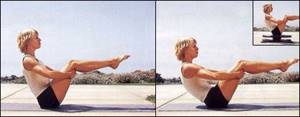
Exercise "Cancan"
Sitting on the floor, bend your knees, lean on your forearms, placing your elbows under your shoulders. The toes should lightly touch the floor, and the legs should be tightly compressed.
Pull your stomach in, take a deep, full breath and at the same time turn your knees to the right side. As you exhale, straighten your knees, raising them diagonally towards your body. The next inhalation is accompanied by the body returning to its original position.
Exhale and perform a similar set of movements directed to the left side.
Alternating between the exercise and controlling your breathing, do several repetitions.
Exercise "Criss-Cross"
Lying on your back, bend and lift your legs so that your ankles are parallel to the floor. Elbows should be spread to the sides, hands behind the head.
Keeping your back firmly pressed to the floor, pull your stomach in. As you inhale, lift your head, neck, and shoulder blades off the floor. As you exhale, straighten your right leg (it will be at an angle of 45 degrees to the floor) and, without bending at the lower back, turn your whole body to the left. On the next inhalation, return the body to its original position without lowering the shoulder blades.
On your next inhalation, perform a similar movement in the opposite direction.
Exercise “Plank Pose”
Standing on all fours, lean on your forearms, placing your elbows under your shoulders and your knees in line with your hips.
Straightening and moving back, place both legs in succession on your toes. The feet should be pressed against each other. Straightening your body from head to heels, assume Plank pose, forming a straight line.
Take a deep breath. Exhaling, lift your hips and lower your head into dolphin pose. On your next inhalation, return your body to the original position.
Exercise "Leg Swing"
The exercise is performed on the floor. Standing on all fours, straighten your arms and place your wrists directly under your shoulder joints. Your legs should be in line with your hips.
Starting the exercise, smoothly straighten, move back and place both legs in succession on your toes, resting and maintaining balance on your toes. The feet must be kept together. Lowering your hips, you need to form a straight line, straightening from the top of your head to your heels.
As you inhale, raise your leg, and as you exhale, lower it. Consistently alternating the right and left legs, the exercise is repeated several times.
Exercise "Mermaid"
With your knees bent, sit comfortably on your right thigh. Rest your right hand on the floor, straightening your elbow and moving your hand away from your body at a distance of no more than 15 cm. Place your left hand, palm up, on your left knee.
As you inhale, push up with your right hand and lift your hips. The left hand should be extended upward. Your posture should resemble the letter "T". Exhaling smoothly, take the starting position.
On your next inhalation, repeat the exercise, switching sides. Alternately perform the exercise first in one direction, then in the other.

Trinity Method – 6 Pilates Principles
Pilates in no case can be considered a regular set of exercises aimed at losing weight, since this technique is based on three main pillars - mind, spirit and body. By training your body using the Pilates technique, you simultaneously train your spiritual nature: you are filled with harmony, learn self-control and become calmer in your reactions.
Pilates for weight loss at home also implies inner composure and a willingness to fully immerse yourself in each session in order to achieve the desired result.
Therefore, the foundation of Pilates is 6 principles that are important to know and remember before training:
- The principle of center alignment of the body is the basis of the exercises. Whichever one you perform, your back should be straight and your muscles tense.
- The principle of maximum concentration. When performing a movement, you must live this moment entirely, immersing yourself in it without reserve. This helps you feel the work of each muscle and remain as focused as possible during the session.
- The principle of deep control. When performing each movement, it is important to constantly monitor the tension in the muscles, not allowing yourself to relax. This applies to all muscle groups - both those involved in a specific exercise and those awaiting load.
- The principle of precise location in space. Straight and symmetrical body without sagging, deflections and other “irregularities”. All parts of the body are on the same line.
- The principle of breathing technique. We always inhale through the nose, exhale through the mouth. We use chest breathing with deep inhalations and exhalations.
- The principle of pulling. During exercise, we stretch the spine: we bring the shoulder blades together and lower the straightened shoulders so that the elongation of the spine is felt.
You can use the Pilates method to lose weight at home or work out in the gym with a trainer - the effect will appear in both cases, it is only important to adhere to the basic principles and not “crash” during classes. Every indulgence to yourself is directly reflected in the result.

Pilates exercises on a ball
Exercise "Pica"
Lying on the ball, slowly walk your hands forward along the floor so that the ball is under your ankles. The body should be parallel to the floor, and the palms should be located under the shoulder joints.
Tighten your abdominal muscles and take a deep, smooth breath. As you exhale, lift your pelvis and, without bending your legs, roll the ball in the opposite direction, towards your hands. On your next inhalation, repeat the exercise from the beginning.
Exercise “Twists of scissors”
Lying on your back, place the ball between your shins. Extend your arms to the sides, placing them at shoulder level, palms down.
With your knees bent 90 degrees, lift the ball off the floor, holding it firmly with your feet. After inhaling, as you exhale, lower your legs with the ball to the right, without lifting your shoulder blades from the floor. On the next inhalation, return to the starting position, and on the exhale, repeat the exercise in the opposite direction.
Exercise "Back stretch"
Sitting on the ball, spread your legs wide and reach your arms towards the floor. Relax your back, neck and shoulder muscles as much as possible. Try to control your breathing by inhaling and exhaling smoothly.
Exercise “Abs Stretching”
Sitting on the ball, take small steps forward, while at the same time slowly leaning back and lying on the ball with your lumbar region. Place your head and shoulder blades on the ball, and spread your arms in different directions. The main points of your body, such as your head, pelvis and back, should be in contact with the ball.
Relax your abs and lower back as much as possible by stretching slightly and controlling your breathing.
Benefits of Pilates
Pilates takes a holistic approach. That is, you do not train your legs separately, your neck separately, and your hands separately. Many muscles are involved in one exercise. Pilates movements complement each other and require mental concentration. This teaches you to direct your thoughts in the right direction and not get scattered, even in everyday life.
Pilates classes do not require large physical investments. All you need is comfortable clothes and a bottle of water. Balls are provided at the very center where you practice. If you decide to study via video, you will have to purchase some equipment for Pilates. As for sportswear, you should have comfortable clothes, nothing unique.
Contraindications for Pilates classes
there are simply no prohibitions or restrictions for classes using this system . All Pilates contraindications boil down to one thing - you cannot perform the exercises carelessly, inconsistently and thoughtlessly .
You should follow the basic principles of Pilates and do all movements smoothly, concentrating your attention and controlling your breathing.
In addition, do not forget that not a single exercise in the system should cause pain. If this happens, you should stop training and consult a trainer.
To summarize, we will dispel the popular myth about the uselessness of Pilates
You may have heard the opinion that Pilates, an exercise for losing weight, is not at all an effective activity, as trainers say about it. In part, this judgment has every right to exist, but only in comparison with other types of training: doing Pilates, you can burn from 200 to 400 kcal in 1 hour, while strength exercises burn up to 600 kcal in the same time, and intense training with cardio load is capable of “destroying” 800 kcal at once.
The difference looks impressive, but this is where we often forget about the fundamental difference between Pilates, which is a gentle technique. This means that you will not only lose weight, but strengthen your joints, make your muscles more elastic, and make your body’s immune defense more stable. Yes, the process will be a little slower, but remember - whoever drives quieter will definitely be further along.
By the way, Pilates is a great way to get in shape for those who started training for the first time or returned to training after a long break. By performing simple movements that force every muscle in your body to tense, you will gently prepare your joints and ligaments for further stress. For the same reason, Pilates with a weight loss ball is suitable for pregnant women, as it very gently and gently helps control weight.
By exercising, you learn to breathe correctly, develop endurance (both physical and internal), and most importantly, shape your figure with pleasure, without exhausting yourself with strength training. Strengthened immunity, a great mood and, in a good sense, a smooth emotional background are a bonus for everyone who discovers Pilates gymnastics.
Uniqueness of the technique
Pilates gymnastics is a system of exercises in which movements are aimed at working the muscle groups of the deepest layers. Deep breathing, which “corresponds” to each movement, helps to achieve this effect. Slow pace, clear control of your body, concentration on each exercise are the distinctive features of Pilates.
Unlike other gymnastic innovations, anyone can do Pilates: the system has no contraindications. Men and women of all ages and fitness levels can achieve maximum training results. Let's list what they are:
Stretching the joints and spine. Slow, well-calculated movements make the body flexible, giving joints mobility. Strengthening muscle fibers, “tightening” the skin. Weight correction. Thanks to the activation of metabolic processes, extra pounds are slowly but surely removed from the body. Improvement of the heart and blood vessels. Regular training allows the blood to be saturated with oxygen, which is necessary to nourish all organs and tissues. The walls of blood vessels become stronger and more elastic. Blood pressure is normalized and the functionality of the heart muscle is improved. Recovery from severe injuries
Slow and smooth movements “protect” from accidental injury, which is very important at the stage of rehabilitation after injury. Use in complex treatment of lumbar disc hernia. Strengthening the abdominal and thigh muscles will help pregnant women prepare for the upcoming birth and make it easier.
Recovery after childbirth. Weakened muscles will quickly recover and become toned. Improved posture.
Distinctive features of Pilates exercises:
- “Soft” and gradual strengthening and stretching of muscles;
- The effect is achieved due to the quality of the movements, so their number is reduced;
- One exercise smoothly transitions into another: the movement is carried out without stopping;
- The correctness of movements consists of smoothness and softness;
- Exercises are performed with control of even and deep breathing;
- The technique involves “pumping” all muscle groups.
Regular exercise will improve your health, give you a good mood and a beautiful figure.
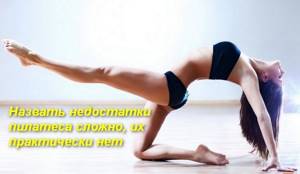
Advantages, disadvantages, contraindications
Using Pilates at home will strengthen your body and improve your spirit. The technique has undeniable advantages:
- The exercises are simple and do not require special physical skills;
- No special equipment is needed for training: beginners only need a mat;
- Detailed video tutorials can replace an instructor;
- Training simultaneously corrects the figure and performs a health function.
It is more difficult to name the disadvantages of the technique; there are practically none. This also applies to contraindications: everyone can practice. The exceptions are conditions in which any activity is harmful:
- Infectious diseases accompanied by increased body temperature;
- Bone tissue injuries: fractures, dislocations;
- Chronic diseases in the acute stage;
- Internal bleeding;
- Mental disorders.
These contraindications are only a temporary obstacle to training: after completing the course of treatment, you can begin performing Pilates exercises.
Necessary recommendations
If you are convinced that there are no contraindications and are determined to practice Pilates at home, read the recommendations of specialists. They will help make your classes more effective.
- Choose clothes made from natural fabrics that do not restrict movement;
- Train barefoot or in thin socks;
- Choose a mat that matches your height;
- Plan your classes so that no one disturbs you: you will need full concentration;
- Plan to train at the same time 3 times a week;
- Eat 1.5 hours before training;
- Don't miss classes;
- Accompany all movements with deep rhythmic breathing, in which the shoulders are lowered and the head is raised high;
- Follow the instructions from the video tutorials;
- During movements, stretch your spine, drawing in your stomach;
- Feeling tired is a reason to finish classes.
Special music used for Pilates classes will help you relax and concentrate.
When doing Pilates exercises for beginners, constantly listen to the sensations of your body: the presence of discomfort “speaks” of incorrectly performed movements.

